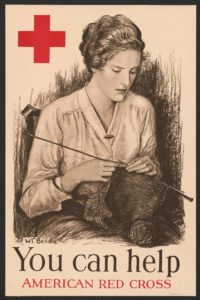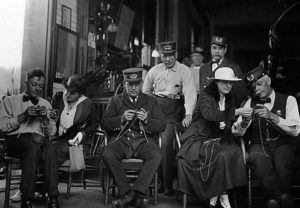Small Home Gazette, Fall 2022
History Brief: The Clacking of Needles
During WWI, there was a huge effort to provide soldiers with warm clothing. In particular, soldiers needed socks. Men were fighting in muddy trenches and wet, sometimes frigid, weather. Keeping feet warm and dry was key to avoiding frostbite and trench foot*. Changing into clean socks regularly was the solution.
Promoted as a patriotic duty, an American Red Cross poster showed a woman intently knitting, with the words, “You can help.” It was not just white women—the effort crossed gender, age, racial and ethnic lines.
Some knitters produced uncomfortable socks. The Red Cross helped standardize patterns plus put together a list of dos and don’ts. Socks suitable for a soldier had to pass three tests: color, size and craftsmanship. American knitters used Olive Whiting’s The Khaki Knitting Book, which offered 50+ pages of instructions for knitted garments for servicemen.
Train conductors knitted between stations; Sing Sing inmates knitted in the prison yard; and wounded soldiers knitted from their hospital beds.
Between 1917 and 1919, Americans knitted 23 million items. Volunteerism at its best!
* Caused by prolonged exposure to damp, cold conditions, trench foot killed about 2,000 American WWI soldiers. The foot becomes numb, changes color, and swells due to damage to skin, blood vessels, and nerves.













